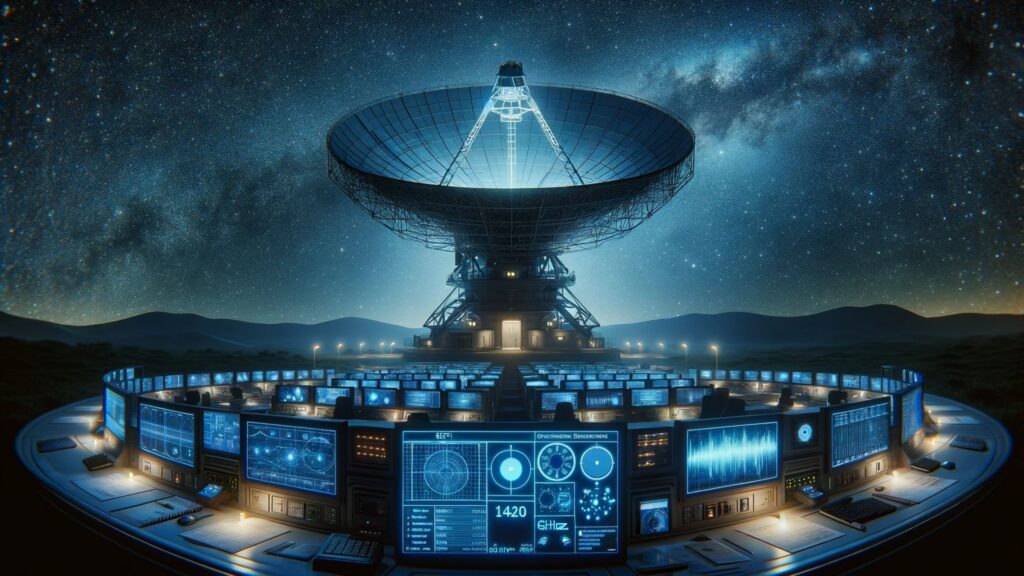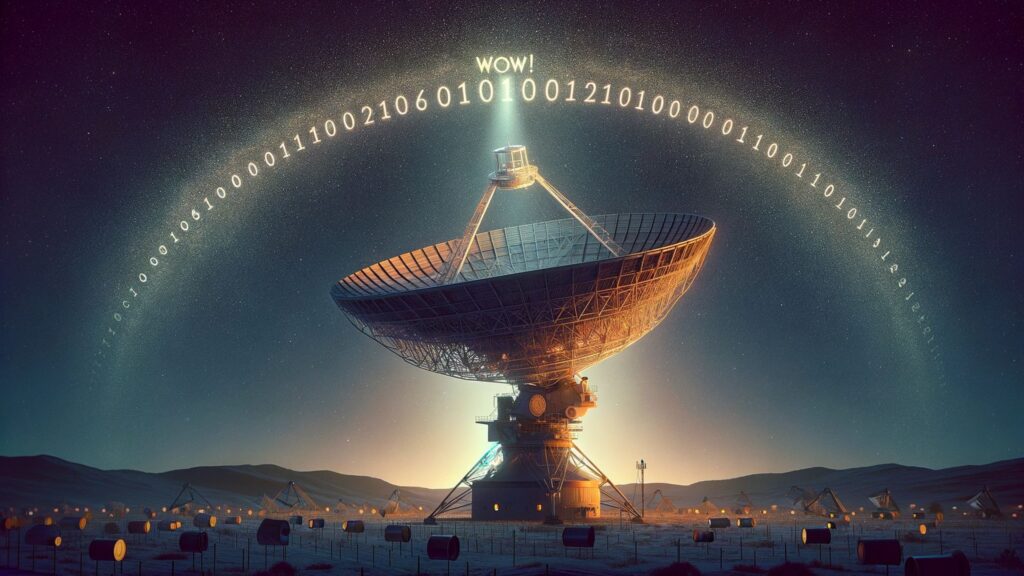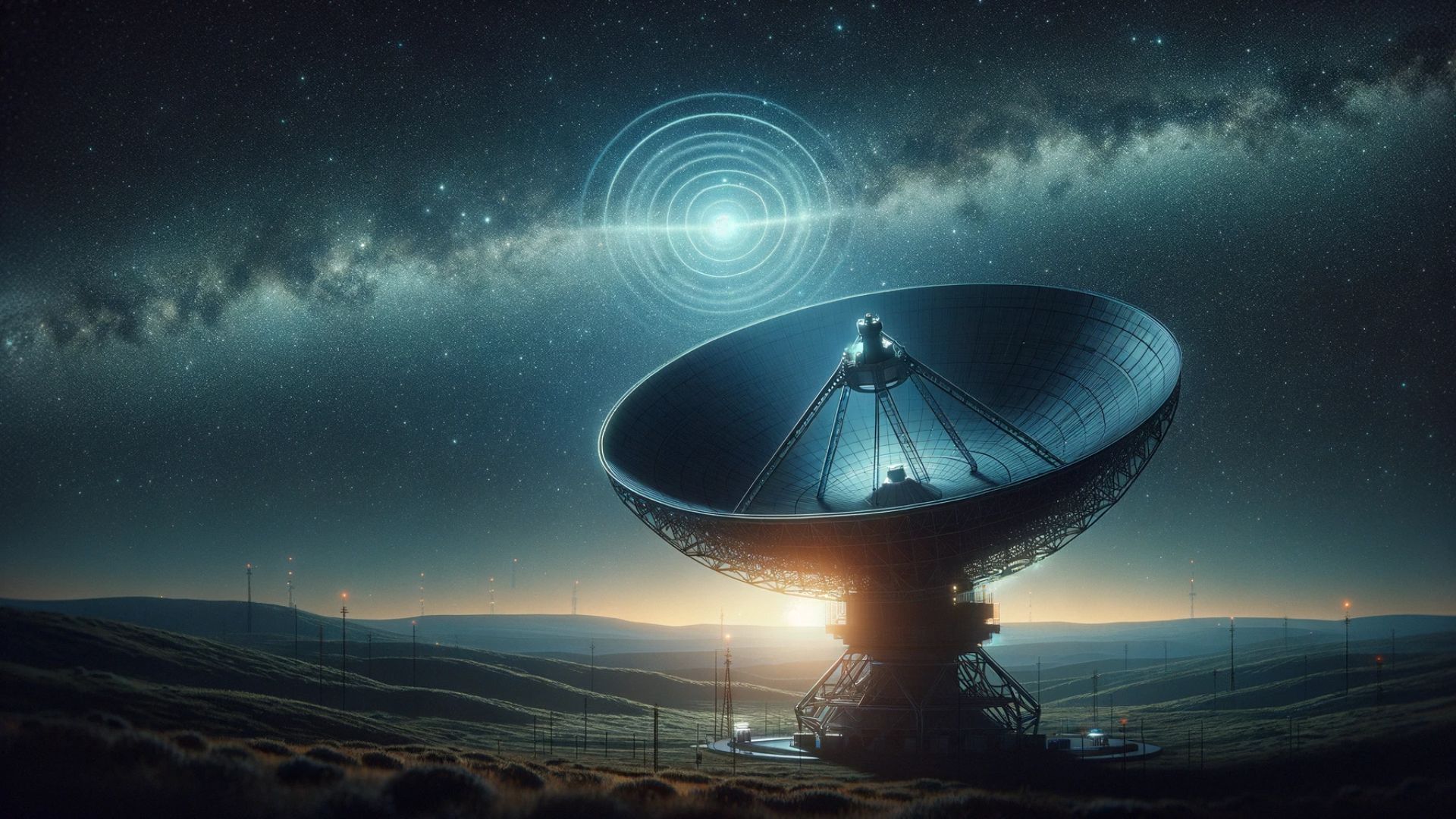The search for extraterrestrial intelligence (SETI) has long captivated the human imagination, posing the tantalizing question: are we alone in the universe? At the heart of this quest lies the mysterious frequency of 1420 GHz, known as the “waterhole,” a prime target in the cosmic search for alien life.
This unique frequency, resonant with the hydrogen line, is considered a universal calling card for advanced civilizations. Adding to the intrigue, the enigmatic “Wow!” signal, detected at a frequency close to the waterhole, has further fueled speculation and hope in the SETI community.
In this exploration, we delve into the significance of the waterhole, the story of the “Wow!” signal, and their roles in the ongoing pursuit of interstellar communication.
Understanding 1420 GHz: The Cosmic Waterhole
The Hydrogen Line
1420 GHz (or 1.420 GHz) is equivalent to a wavelength of about 21 cm. This frequency is significant because it corresponds to the hydrogen line or the frequency at which neutral hydrogen atoms emit photons. Hydrogen, being the most abundant element in the universe, creates a natural and ubiquitous marker in the cosmic landscape.
The Waterhole Concept
The term “waterhole” is an analogy drawn from wildlife, where different species converge at a waterhole. In a cosmic sense, the waterhole represents a frequency range where intelligent life might converge for communication. This range lies between the hydrogen line (1420 MHz) and the hydroxyl ion (OH) line (1666 MHz). The combination of H (hydrogen) and OH (hydroxyl) forms H2O, water, a fundamental ingredient for life as we know it.
SETI and 1420 GHz

SETI’s Search Strategy
The Search for Extraterrestrial Intelligence (SETI) has long been intrigued by the 1420 GHz frequency. The rationale is that other intelligent civilizations seeking to communicate across interstellar distances, might also recognize the uniqueness of the hydrogen line. Using this frequency could be seen as a universal “hailing frequency” for advanced civilizations trying to make contact.
Advantages for Communication
The choice of 1420 GHz is not just symbolic. This part of the electromagnetic spectrum has several practical advantages:
- Low Interference: The universe is relatively quiet in this range, reducing background noise.
- Penetrative Ability: These waves can travel vast distances without being significantly absorbed by the interstellar medium.
- Technical Feasibility: It’s within the capability of human technology to monitor and broadcast at this frequency.
The “Wow!” Signal: A Puzzling Chapter in SETI’s Search

The “Wow!” signal remains one of the most intriguing and enigmatic events in the history of the Search for Extraterrestrial Intelligence (SETI). Discovered on August 15, 1977, by Dr. Jerry R. Ehman, an astronomer at Ohio State University’s now-defunct Big Ear radio telescope, the signal epitomizes the ongoing quest to detect extraterrestrial intelligence.
Discovery and Characteristics
The signal appeared as a strong, narrowband radio signal lasting 72 seconds, the maximum time Big Ear could observe any single point in the sky due to Earth’s rotation.
It was detected at a frequency of 1420.456 MHz, tantalizingly close to the hydrogen line (1420 MHz) in the waterhole region, a frequency not used by terrestrial sources like satellites or broadcast stations. The intensity and frequency of the signal led Ehman to excitedly write “Wow!” in the margin of the printout, giving the signal its name.
Significance in SETI Research
The “Wow!” signal is significant for several reasons:
- Unique Occurrence: Despite numerous attempts, the signal has never been detected again, adding to its mystery.
- Perfect Frequency: Its close proximity to the hydrogen line, in the waterhole spectrum, aligns with what many scientists theorize would be an ideal frequency for interstellar communication.
- No Terrestrial Explanation: To date, no definitive terrestrial source or natural astronomical phenomenon has been identified as the cause of the “Wow!” signal, leaving its origin open to speculation.
Implications and Legacy
While the “Wow!” signal has not been replicated, its legacy endures in the SETI community. It serves as a benchmark for signal detection protocols and continues to inspire the search for extraterrestrial intelligence. The signal’s unexplained nature keeps the possibility of alien communication open, a tantalizing prospect that fuels ongoing research and exploration in the field.
The “Wow!” signal, with its enigmatic characteristics and enduring mystery, remains a symbol of the limitless possibilities that lie in the vast expanse of our universe and underscores the importance of continuous observation and research in the field of SETI.
The Challenges and Critiques
Limitations in Scope
While the waterhole is a compelling region to search, it’s important to acknowledge that focusing solely on this narrow band might limit our chances of detecting alien signals. Extraterrestrial civilizations, if they exist and are transmitting, might not be using this frequency or even radio waves.
The Need for Broadened Search
Consequently, some in the SETI community advocate for a broader approach, encompassing a wider range of frequencies and even different types of signals, like optical or infrared.
Looking Ahead: The Future of SETI and the Waterhole

The waterhole remains a key part of SETI’s search strategy, but it’s increasingly complemented by more expansive search techniques. Projects like the Breakthrough Listen initiative are scanning a broader range of frequencies, while others are exploring alternative communication methods.
Conclusion
In conclusion, the exploration of the 1420 GHz frequency and the waterhole, together with the captivating narrative of the “Wow!” signal, highlights the fascinating journey of SETI in its search for extraterrestrial intelligence.
The Waterhole: A Cosmic Beacon
The waterhole frequency stands as a beacon in the cosmic wilderness, guiding our search for alien life. It represents the collective hope and scientific ambition to discover other forms of intelligence within the vast expanse of space. This frequency is not just a technical target; it’s a symbol of our quest to understand the universe and our place within it.
The “Wow!” Signal: A Persistent Mystery
The “Wow!” signal, with its unresolved origin and singular occurrence, continues to intrigue and inspire. It serves as a reminder of the vast unknowns in our universe and the potential for extraordinary discoveries. The enduring mystery of this signal fuels ongoing research and speculation, keeping the spirit of exploration alive in the SETI community.
Reflecting on the SETI Endeavor
The SETI quest, encompassing the waterhole and the “Wow!” signal, is more than a scientific endeavor; it’s a reflection of humanity’s enduring curiosity and desire to connect with the cosmos. Whether we ultimately find extraterrestrial intelligence or not, the search itself is a testament to our technological advancements and our relentless pursuit of knowledge. The journey through SETI’s challenges and discoveries reminds us of our small but significant place in the universe.
To delve deeper into similar mysteries and explore other enigmatic phenomena in the realm of extraterrestrial exploration, I invite you to read further on our website. A particularly fascinating piece is “Unveiling the Mystery: David Grusch’s UFO Claims and the Ghost Rockets Phenomenon,” which offers an in-depth look into other intriguing aspects of aerial phenomena and their place in the broader context of searching for life beyond Earth.

